Aloe vera, also known as "sábila" in Spanish, is a popular indoor plant cherished for its numerous health benefits and exotic beauty. Originally from arid regions, aloe vera has become a common plant in homes worldwide due to its easy cultivation and healing properties.
For those living in the vibrant city of New York, aloe vera is an ideal choice as an indoor plant. Its ability to adapt to different light conditions and its resistance to dry climates make it a perfect companion for New Yorkers. From small apartments with limited natural light to spacious lofts with sunny windows, aloe vera easily adapts to any space. Place an aloe vera in the living room to add a touch of freshness and purify the air, or in the kitchen to have its nutritious gel at hand. Furthermore, its exotic beauty and ability to thrive in urban environments make aloe vera a smart choice to bring a touch of greenery and serenity to the city that never sleeps.
Health Benefits
Aloe vera is renowned for its healing and medicinal properties. Its transparent gel, found in the plant's leaves, contains antioxidant, anti-inflammatory, and antibacterial compounds that can benefit our skin, digestive system, and immune system. From relieving burns and insect bites to promoting wound healing and improving digestion, aloe vera offers a wide range of health benefits.
Aloe Vera: A Natural Remedy for Prediabetes
Aloe vera has been used for centuries in traditional medicine to treat a variety of conditions, including diabetes and prediabetes. The gel of aloe vera is believed to have antidiabetic properties and can help regulate blood sugar levels.
The gel of aloe vera contains several bioactive compounds that may contribute to its beneficial effect on prediabetes. These compounds include polysaccharides, polyphenols, and phytosterols, which have anti-inflammatory, antioxidant, and antidiabetic properties.
Studies in animals and cell cultures have shown that aloe vera can improve insulin sensitivity and increase glucose uptake by cells. It has also been observed that aloe vera can reduce blood glucose levels and improve glucose tolerance in people with prediabetes.
A study published in the Journal of Clinical Pharmacy and Therapeutics investigated the effects of aloe vera on people with prediabetes. The study participants were given an aloe vera gel supplement for 12 weeks, and a significant decrease in blood glucose levels was observed compared to the control group.
However, it is important to note that studies on the use of aloe vera in prediabetes are limited, and more research is needed to confirm its effectiveness and determine the appropriate dosage.
Additionally, caution should be exercised when using aloe vera as consuming it in large quantities or for an extended period may have laxative effects and cause stomach discomfort. It is advisable to consult with a healthcare professional before incorporating aloe vera as part of a prediabetes treatment plan.
To use aloe vera as a natural remedy for prediabetes, it is important to follow a few steps to obtain and prepare the gel from the plant:
Plant selection: Look for a healthy and mature aloe vera plant. Opt for the larger, fleshy leaves as they contain more gel.
Preparation: Wash the aloe vera leaves with water to remove any dirt or impurities. Then, place the leaves upright for several minutes to allow the yellow liquid called aloin (which has laxative properties) to drain.
Gel extraction: Use a sharp knife to trim the edges of the leaves and then make a longitudinal cut along the leaf. Carefully peel off the top layer of the leaf to reveal the transparent gel inside.
Aloin extraction: Gently scrape the bottom of the leaf with a spoon to remove any remaining aloin. Avoid including any yellow portion in the gel, as it may have unwanted laxative effects.
Storage: Transfer the aloe vera gel to a clean container and store it in the refrigerator. The gel will stay fresh for several days.
Care and Maintenance
Aloe vera is an easy-to-care-for plant, making it a perfect choice for those without previous gardening experience. It requires ample exposure to direct sunlight, so it is advisable to place it near a sunny window. Additionally, aloe vera prefers well-drained soil and does not need to be watered frequently. It is important to avoid overwatering, as this can damage the roots and lead to plant rot.
Propagation and Multiplication
If you want to have more aloe vera plants in your home, you can easily propagate them through stem cuttings or offsets. Offsets are small plantlets that grow around the mother plant and can be carefully separated and replanted. Additionally, it is also possible to grow new plants from cut aloe vera leaves. These propagation methods allow you to expand your collection of aloe vera and share it with friends and family.
Decorative Uses
In addition to its health benefits, aloe vera is a decorative indoor plant that adds a touch of freshness and elegance to any space. Its succulent, intensely green leaves and architectural form make it a popular choice for interior decoration. You can showcase your aloe vera in ceramic pots, hang it in baskets, or even create arrangements by combining it with other plants. Aloe vera is truly versatile and adapts to different styles of decor.
Aloe vera is a versatile indoor plant filled with benefits. Whether it's for improving our health, its easy care, or its aesthetic appeal, aloe vera is an excellent addition to any home. Ensure you provide it with the proper conditions of light, watering, and soil, and you will soon enjoy the beauty and benefits it brings to your space.


